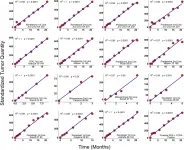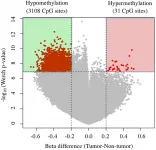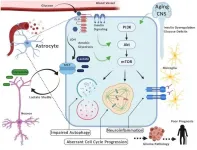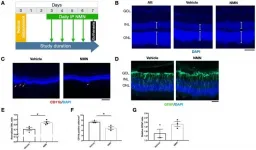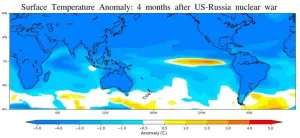(Press-News.org) The cover for issue 1 of Oncotarget features Figure 2, "Results in clinical trials," published in "Drug resistant cells with very large proliferative potential grow exponentially in metastatic prostate cancer" by Blagoev, et al. which reported that most metastatic cancers develop drug resistance during treatment and continue to grow, driven by a subpopulation of cancer cells unresponsive to the therapy being administered.
There is evidence that metastases are formed by phenotypically plastic cancer cells with stem-cell-like properties.
Currently, the population structure and growth dynamics of the resulting metastatic tumors is unknown.
Here, using scaling analysis of clinical data of tumor burden in patients with metastatic prostate cancer, the Oncotarget authors show that the drug-resistant, metastasis-causing cells are capable of producing drug-resistant, exponentially growing tumors, responsible for tumor growth as a patient receives different treatments.
The Oncotarget authors show that the drug-resistant, metastasis-causing cells are capable of producing drug-resistant, exponentially growing tumors, responsible for tumor growth as a patient receives different treatments
Dr. Krastan B. Blagoev from The National Science Foundation, as well as The Johns Hopkins University, said, "Tissue homeostasis is maintained by a small number of stem cells capable of symmetrical and asymmetrical cell division, with symmetrical cell division ensuring that the number of stem cells remains constant when a stem cell is lost and asymmetrical cell division maintaining the stem cell number constant when all stem cells are present."
Currently, it is thought that cancers emerge from one or both of these two cell populations, and cancer cells possessing stem cell markers and capable of proliferating when grafted in animal models have been identified in leukemia and solid tumors, and have been called cancer stem cells.
The epithelial to mesenchymal transition has been implicated in cancer cells and there is evidence that the metastatic-capable cells are somewhere on the spectrum between fully epithelial and fully mesenchymal cells while the metastasizing cells are phenotypically plastic and capable of moving along that spectrum.
Recently it was reported that the WNT/ß-Catenin pathway drives prostate cancer cells into symmetric cell divisions, suggesting that these cancer cells have lost the ability to divide asymmetrically.
The inner surface of the ducts is covered with epithelial luminal cells, which are surrounded by epithelial basal cells and scattered among them are neuroendocrine cells.
The Blagoev Research Team concluded in their Oncotarget Research Paper that the environment where normal stem cells reside in the stem cell niche populated with supporting cells and having an organized tissue architecture.
In contrast, cancers lose the polarized structure of the cells present in normal tissue, grow as bulk cell masses, and break the basal membrane surrounding the prostate to metastasize to distant cites.
Both mechanisms may be in play and further research is needed to characterize the architecture of the metastatic tumors and the operating cell division mechanisms. Currently, the origin of these symmetrically dividing cells is unclear.
One possibility is that one or more cancer stem cells begin to divide symmetrically overtaking the asymmetrically dividing cells.
Observation of the tumor at the individual cell level as well as monitoring of molecular markers of individual cells will be necessary to resolve the drivers behind phenotypic cell decisions in normal and cancerous tissues.
Sign up for free Altmetric alerts about this article
DOI - https://doi.org/10.18632/oncotarget.27855
Full text - https://www.oncotarget.com/article/27855/text/
Correspondence to - Krastan B. Blagoev - krastan@jhu.edu
Keywords -
drug resistance,
metastatic prostate cancer,
exponential growth,
tumor kinetics,
cancer stem cells
About Oncotarget
Oncotarget is a biweekly, peer-reviewed, open access biomedical journal covering research on all aspects of oncology.
To learn more about Oncotarget, please visit https://www.oncotarget.com or connect with:
SoundCloud - https://soundcloud.com/oncotarget
Facebook - https://www.facebook.com/Oncotarget/
Twitter - https://twitter.com/oncotarget
LinkedIn - https://www.linkedin.com/company/oncotarget
Pinterest - https://www.pinterest.com/oncotarget/
Reddit - https://www.reddit.com/user/Oncotarget/
Oncotarget is published by Impact Journals, LLC please visit http://www.ImpactJournals.com or connect with @ImpactJrnls
The cover for issue 52 of Oncotarget features Figure 1, "Volcano plots of DNA methylation in tumor tissues compared with nontumor tissue," published in "Reduction of T-Box 15 gene expression in tumor tissue is a prognostic biomarker for patients with hepatocellular carcinoma" by Morine, et al. which reported that the authors conducted a genome-wide analysis of DNA methylation of the tumor and non-tumor tissue of 15 patients with Hepatocellular carcinoma (HCC), and revealed TBX15 was the most hypermethylated gene of the tumor.
Another validation set, which comprised 58 HCC with radical resection, was analyzed to investigate the relationships between tumor phenotype and TBX15 mRNA expression.
TBX15 mRNA levels in tumor tissues were significantly lower compared ...
Aging-US Issue 1 Volume 13 features "PAM (PIK3/AKT/mTOR) signaling in glia: potential contributions to brain tumors in aging" which reported that despite a growing proportion of aged individuals at risk for developing cancer in the brain, the prognosis for these conditions remains abnormally poor due to limited knowledge of underlying mechanisms and minimal treatment options.
While cancer metabolism in other organs is commonly associated with upregulated glycolysis and hyperactivation of PIK3/AKT/mTOR pathways, the unique bioenergetic demands of the central nervous system ...
Aging-US published "Neuroprotective effects and mechanisms of action of nicotinamide mononucleotide (NMN) in a photoreceptor degenerative model of retinal detachment" which reported that here, the authors investigated nicotinamide mononucleotide, a precursor of nicotinamide adenine dinucleotide, in a retinal detachment induced photoreceptor degeneration.
NMN administration after RD resulted in a significant reduction of TUNEL photoreceptors, CD11b macrophages, and GFAP labeled glial activation; a normalization of protein carbonyl content, and a preservation of the outer nuclear layer thickness.
NMN administration significantly increased NAD levels, SIRT1 protein expression, and heme oxygenase-1 expression.
Delayed NMN administration still exerted protective effects after RD.
This ...
A nuclear war could trigger an unprecedented El Niño-like warming episode in the equatorial Pacific Ocean, slashing algal populations by 40 percent and likely lowering the fish catch, according to a Rutgers-led study.
The research, published in the journal END ...
DALLAS, Jan. 25, 2021 -- Psychological health can positively or negatively impact a person's health and risk factors for heart disease and stroke, according to "Psychological Health, Well-Being, and the Mind-Heart-Body Connection," a new American Heart Association Scientific Statement, published today in the Association's flagship journal Circulation. The statement evaluates the relationship between psychological health and heart health, summarizing ways to help improve psychological health for people with and at risk for heart disease.
"A person's mind, heart and body are all interconnected and interdependent in what can be termed 'the mind-heart-body-connection,'" said Glenn N. Levine, M.D., FAHA, master clinician and professor of medicine at ...
DALLAS, Jan. 25, 2021 -- The continued global burden of stroke and how it disproportionately affects women are highlighted in new science published online today in the February issue of Stroke, a journal of the American Stroke Association, a division of the American Heart Association. Stroke editors selected nine manuscripts focused on stroke disparities in women in this collaboration with Go Red for Women®, the Association's global movement to end heart disease and stroke in women.
"Stroke continues to be a leading cause of death and disability worldwide, with women being more adversely affected by the global burden of stroke," said Stroke Editor-In-Chief Ralph L. Sacco, M.D., M.S., FAHA, ...
Scientists have identified a key nutrient source used by algae living on melting ice surfaces linked to rising sea levels.
The Greenland ice sheet - the second largest ice body in the world after the Antarctic ice sheet - covers almost 80% of the surface of Greenland. Over the last 25 years, surface melting and water runoff from the ice sheet has increased by about 40%.
The international research team, led by the University of Leeds, analysed samples from the southwestern margin on Greenland's 1.7 million km² ice sheet over two years.
They discovered that phosphorus containing minerals may be driving ever-larger algal blooms on the Greenland Ice Sheet. As the algal blooms grow they darken the ice surface, decreasing albedo - ...
EAST LANSING, Mich. - An international team of researchers led by Michigan State University's Morteza Mahmoudi has developed a new method to better understand how nanomedicines -- emerging diagnostics and therapies that are very small yet very intricate -- interact with patients' biomolecules.
Medicines based on nanoscopic particles have the promise to be more effective than current therapies while reducing side effects. But subtle complexities have confined most of these particles to research labs and out of clinical use, said Mahmoudi, an assistant professor in the Department of Radiology and the Precision Health Program.
"There's been a considerable investment of taxpayer money in cancer nanomedicine research, but that research hasn't successfully translated ...
Even before public announcements of the first cases of COVID-19 in Europe were made, at the end of January 2020, signals that something strange was happening were already circulating on social media. A new study of researchers at IMT School for Advanced Studies Lucca, published in END ...
The rate at which ice is disappearing across the planet is speeding up, according to new research.
And the findings also reveal that the Earth lost 28 trillion tonnes of ice between 1994 and 2017 - equivalent to a sheet of ice 100 metres thick covering the whole of the UK.
The figures have been published today (Monday, 25 January) by a research team which is the first to carry out a survey of global ice loss using satellite data.
The team, led by the University of Leeds, found that the rate of ice loss from the Earth has increased markedly within the past three decades, from 0.8 trillion tons per year in the 1990s to 1.3 trillion tons per year by 2017.
Ice melt across the globe ...
